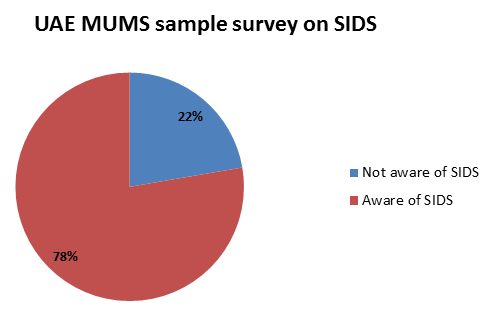Brace yourselves mothers, this is a
scary issue for all of us!
To start with, I learnt about SIDS
by mistake one afternoon when I was reading a couple of articles about newborn
sleep patterns. Since that day on wards and I’m guilty of constantly checking my
baby’s breathing at night since I put him to sleep on his tummy.
I find it highly important for mothers and
caregivers to understand what SIDS is and what measures can be taken to best
prevent it. Fortunately in a survey done on a
sample of the UAE MUMS community, the majority of participants acknowledged
that they were ‘aware of SIDS’.
Here’s to educate who aren't aware of SIDS and to better
explain it to those who are:
What’s SIDS?
Sudden Infant
Death Syndrome (SIDS) is also referred to as the “crib death” or
“cot death”. Why? Since most cases occurred while babies were sleeping.
SIDS is
diagnosed when the death remains unexplained after a thorough case
investigation, including performance of a complete autopsy, examination of the
death scene and review of the clinical history. Watch out scary figures ahead! According
to Baby Center Approximately 2,300 infants die
from SIDS in the United States each year, 90 percent of cases involve infants
younger than 6 months.
Unveiling the truth about SIDS:
What scares me about SIDS is
the lack of a definitive answer to its causes. Going
through at least 20 credible sources on the web, I’m dazzled to find out that
each had a quit distinctive approach to SIDS.
"If we knew
exactly what causes it, we wouldn't call it SIDS," said Dr. John
Kattwinkel, the chairman of the pediatric academy's task force on the syndrome,
to New York Times.
However, the most
acceptable theory is the triple-risk model that was first put forth by Dr.’s JJ Filiano and HC
Kinney at Boston’s Children’s Hospital in 1994, it states that three factors must pile-up for SIDS to
occur:
SIDS occurs to the
infant with an underlying biological vulnerability (such as immature or
abnormal functioning of the heart, breathing, arousal or having lower than
normal levels of serotonin in the brainstem), exposed to an external trigger
(such as sleeping tummy-down or on soft bedding) and who is at a critical
developmental age.
Researchers were
able to identify some risk factors of SIDS:
- Baby’s sex: Boys are more likely to have SIDS, by a ratio of 1.5 to 1.
- Baby’s age: Babies are most vulnerable in their second and third month of life.
- Baby’s race/ethnic background: For unknown reason certain races are more likely to develop SIDS, such as African Americans, American Indians and Eskimo.
- Baby’s family history: Having siblings or cousins that died from SIDS puts a baby in a higher risk of developing SIDS.
- Premature Babies: The earlier the baby is born the higher the risk of SIDS.
- Being born to a mother under the age of 20: Teen mothers are more likely to have babies that suffer from SIDS.
Lowering the risk of SIDS:
- Try to put your baby to sleep on his back: Deaths from SIDS has dropped about 50 percent since 1994, when the Back to Sleep campaign was launched. Moreover, theories stated that babies who are placed on their stomachs or sides to sleep may have more difficulty breathing than those placed on their backs. Once your baby is able to roll over (at 6 months roughly) it’s fine to leave him in whatever position he chooses to sleep in. Luckily the vast majority of the UAE MUMS in the survey put their babies to sleep on their back.
- Prevent putting your baby to sleep on a soft surface.
- Prevent unsafe co-sleeping: The risk of SIDS increases if the baby sleeps in the same bed with his parents.
- Stop smoking, drinking alcohol and using illegal drugs during pregnancy: Almost all studies stated that these acts during pregnancy are risk factors for SIDS, plus affecting the baby’s health.
- Breastfeed your baby: A large German study published in 2009 concluded that both partial breastfeeding and exclusive breastfeeding are associated with a reduction in SIDS. In fact, the researchers determined that exclusive breastfeeding until 1 month of age cut the risk of SIDS in half! (Baby center). Thumbs up to breast feeders!
It’s never too late to adjust your
baby’s sleep habits into safer options. Personally I’ll try my best to put my
future babies to sleep on their backs, who wouldn't want to lower the possible
risk?
Mothers will try their best to protect their babies but what form of protection
is more legit than praying for God to keep them safe and sound.
Kisses to the little ones! :)



Yes SIDS is a very scary issue and one of those mysteries of the world. But the guidelines you have given to prevent this from happening really are worth implementing. This is an excellent eye opener, thank you.
ReplyDeleteYou're most welcomed Rahima. Thank you
DeleteI always put my nephew to sleep on a soft surface...thks for the awareness & great article :)
ReplyDeleteThank you Shazia :)
Deletevery informative...thanx Soumayya.. :)
ReplyDeleteYou're most welcomed Sahar
Delete